Rebecca Ashton sits in on German professional, Stefan Wolff’s clinic, and finds that good training is… basic.
Rebecca also took the photos…
If you’re expecting to go to a Stefan Wolff clinic and see a lot of fancy movements, you might be disappointed. Stefan is not a trainer who will pull out the fancy things just to make the client happy. A lot of “frames” are dismantled and, yes, you guessed it, basics, basics, basics. Horses are taken right back to “forward and straight”; getting them to seek the bit instead of backing off it, riding more from the seat and legs, getting the horses forward correctly from the aids, and allowing them to flow without restriction, independent in their work, filling out and creating their own frames.
Lesley Ann Taylor had her new stallion, Fermento in the arena. Having just come off a break, rider and trainer were taking it easy on the big chestnut, but that didn’t mean the work didn’t have to be correct. The youngster is a bit of a teenager and would like Mum to help more. The task was to rebalance him a little onto his hindquarters, get him to carry himself and not run through the rein. The key was to get some looseness through his big body. Stefan encouraged:
“Have him more in front of you. It is natural with a horse that strong to think back, back, back, but he still needs to be in front of you. If you fight against his fighting muscle, you’ll lose. Forget about it. Instead focus on the other; focus on the stretching muscle, keeping him through his back and stretching. Not slower. You need to build pre-collection, not collection at this stage. Don’t shorten him up. Once he starts loosening up, it gets better. His strength comes when he pulls down. Feel that every stride ends upward in the hand, not down. There you go.”
Stefan asked for shoulder fore across the diagonal to sensitize the horse and the challenge was to keep the hind legs on a straight track as the shoulders moved from right to left, “Don’t let the hind leg go in the opposite direction of the flexion. Change in bend is a process, not a hop from one side to the other. It should have a massaging affect.”
“You need to keep him busy all the time. You can’t stay in the same thing for 10 strides. You need full-on gymnastics to confront his tight muscles. Variations make the difference. Do uncommon lines as well. For example, lengthen the trot on the diagonal, two thirds of the way across bring him back and circle 10 metres. At this stage, I would never bring this horse back without the bend so he doesn’t hang onto the bridle.”
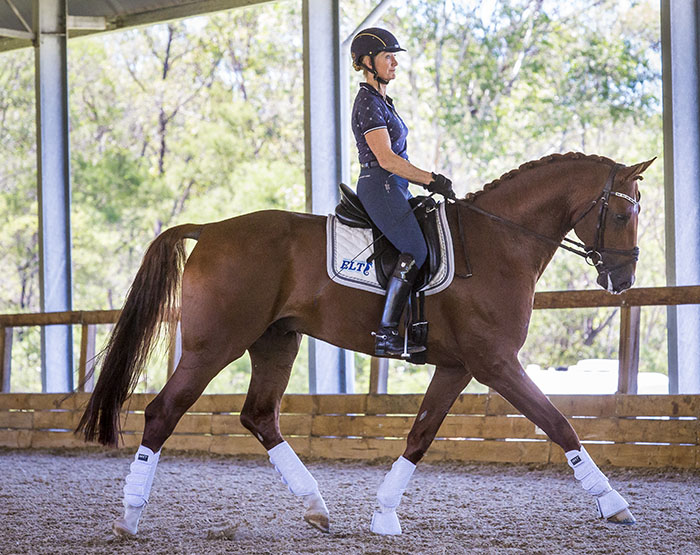
Gradually it improved and Fermento’s frame gained more stretch, and the stallion carried himself better from behind. There still needed to be a touch better connection with the rein in the new frame. “Giving at the wrong moment can be the wrong aid as well. He needs to find you. He’s opening the neck now, but he needs to find your hand comfortable. Your hand needs to be soft and inviting. There you go. He must not be suspicious.”
Subtle adjustments were also a requirement for the seat. To improve the balance of the horse, Stefan wanted Lesley to allow the horse to adjust under her. “Don’t push him away with your seat. Just make room. Feel the back come through. Lighten the knee and leg a little.” The stallion adjusted accordingly. “The measure of throughness is tempo. Medium tempo is a measure of throughness, the test that they are on the seat and not pushing through or collapsing.”
Lesley was now cantering 20 metre circles and asked for a change in direction. Stefan is always trying to help the horse by finding the easiest lines and the smoothest way, you’ll never see anything stop/start sudden in his training. The youngster got a bit tangled in the change of rein so Stefan offered some advice, “Maybe you should have made the line a bit straighter in between the circles rather than change circle to circle. Find inviting lines for him.” The second try proved successful and it was time for a stretch and a big pat.
next a stallion competing at Advanced level
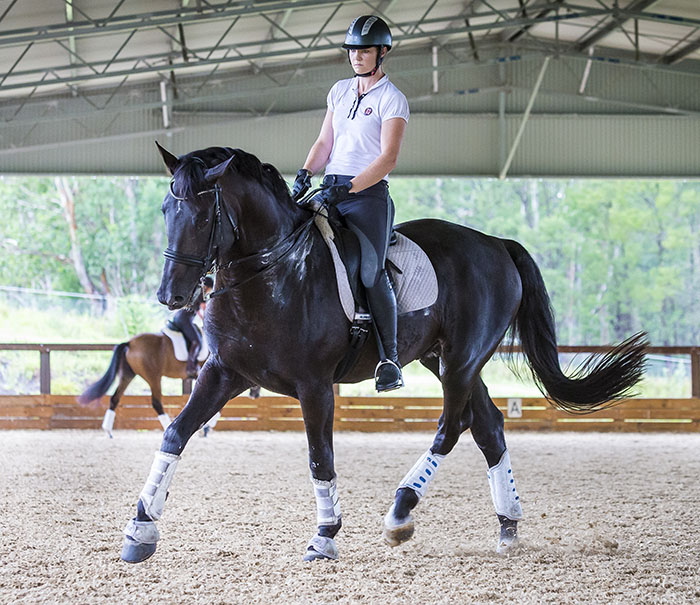
Davena Conroy was next with her big, black Richmond H stallion, Rubicon 1. The pair have been competing at Advanced, but Stefan too wanted this stallion to rebalance a bit more and be more independent in his position and way of going.
“It shouldn’t be complicated to keep him together in an even tempo. You have too much to do at Advanced/PStG to have 80% of your aids keeping the horse going. You need your attention to be on riding all the different movements and preparing for them.”
“Start with the reins a bit longer. Try and get a consistent bend. When he pushes down, let the half halt be the second step, first try and get him in front of you. Try not to lean forward when you give. Just give your hands forward. Have the feeling the hand is below the poll and give. The hand must stay behind the mouth not above the mouth. Put your hands where you want and use the rest of your aids to push him there and connect him to it.”
“The higher the hand, the more the correct line of lower arm and rein is gone. The bit will twist in the mouth and the joint will point downward and the horse will give in that direction, so if the horse’s head is coming lower, you need to take your hand lower.”
“Don’t look into the horse. Look forward. Good. Now he’s into the outside rein. See now if you can do these adjustments on a smaller scale. Don’t wait and then give him a big half halt.
“Find that your seat is the centre of everything. When he pulls forward and downwards, he pops you off his back. Right. Now he lets you sit. His centre of gravity is under your seat. This is now a natural balance for him. He can stay there for a longer time. Take your time to give, but let it have a lasting effect. Don’t throw the rein away, just have a tendency, have a dynamic hand.”
Whenever the stallion wanted to suck back, Davena had to concentrate on two things; her hands had to have a tendency to give and she had to encourage Rubicon to use his back better. This was developed using tempo changes. Stefan explained, “You have to teach him to use his neck again; use his back. Do tempo differences, especially forward. Sit. Relax more in your lower back. The upper body stays level. Regardless of how much you want your horse to collect, you have to keep the flow. Get him to move more through his body.”
“You can ride five different tempos on this circle. Get busy with them. You ride a very nice change downwards, but not so clear forward. There, that was better. Inside hand forward and lighter. Then the inside leg just pushes straight forward. There you go. When you feel him getting a bit hesitant in the canter, do the tempo changes. You have to keep him reaching forward when he comes back. Let him settle onto the bit when he comes back. You can make small variations in tempo, even in the test, just small so no one can see.”
The same rules applied in the walk when things got a little sticky, the rider needed to make a change and then refine it, “Trot transition. Sharp. Make a variation when he gets stuck. Then get to the point when it’s not a trot transition, just that he moves forward a bit more from a squeeze of the leg.”
Things were improving and the basics at a point where Stefan was ready for the combination to try some movements, “Now he swings out with the front leg, the rhythm is even as is the contact. Now ride some movements and try to maintain these basics.
Davena went on to execute shoulder in down the long side. “Getting the horse into the shoulder in is critical for the whole movement. Come again. As you enter the corner, you must already have the correct bend. Remember, don’t get it with the inside rein. Get the same bend, but with the inside leg instead.” This was another important point Stefan made with quite a few riders; use of the diagonal aid. He was strict in not letting riders pull with the inside rein.
“Ride offensively down that long side in shoulder in. This is the coarse idea of how to get into shoulder in. After that you can work on the detail. Always refresh the aid in the movement.”
This developed into half pass work at the trot. “Don’t ride one half pass all the way over. After two half pass strides, ride two steps forward. Then the next time, one step half pass, one step forward. Variations. Outside rein stabilises the shoulder. When it’s not going well, ride him straight, even if it’s just one stride.”
By the end Rubicon was happily purring along with a nice contact and good neck.
another youngster next
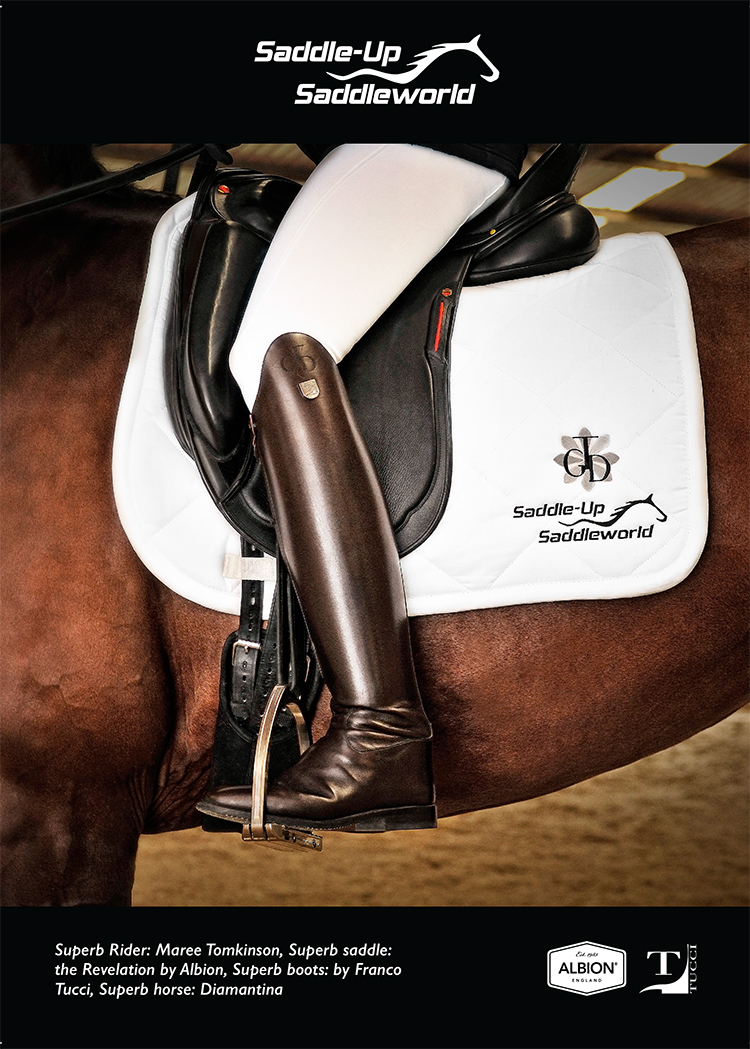
Ring Saddle-Up for more information-03 9727 4000 Or visit them at DJWTS this weekend
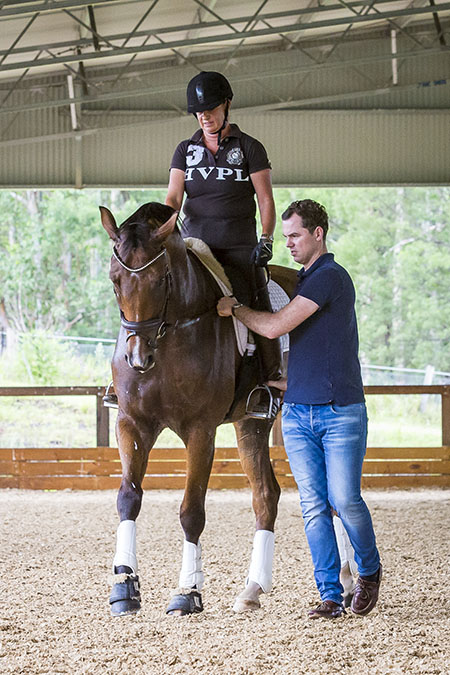
Caroline Hooper had her smart, newly imported Becks Gold II (who we met in the masterclass) and he wanted to go. Again Stefan’s focus was to make the way easy for the horse, “Get him to focus on one thing, not five.” To get the youngster’s attention, Stefan suggested lots of curved lines. “Keep turning. Keep a consistent turn. Don’t wrestle him down, just allow with your hand. Get a proper turn. That means, let him go with your inside hand and use your inside leg and outside rein. You want an even bend through the whole body. Don’t flex the poll more than the bend of the rest of the body. Get him to bend from your inside leg. He shouldn’t go faster. That’s not putting your leg on, that’s kicking. You want to move his shoulder not his mouth. Move the forehand sideways not the head. That’s why you need the outside rein. You can actually turn without the flexion. Let him take the bit forward, not lower.’
“I don’t mind if you’re in counter flexion for a few strides if it puts the forehand in the correct place. Good, he’s looking for your leg now. Let him come to it. He needs to not only know where the contact is in front, but also the backside of the frame. With normal and hot horses, you need contact with the leg, not pushing, just contact. Not just the rein, but the leg as well. The flow was good.”
The youngster started to relax so Stefan introduced the next step, “Do some halt/walk and then trot/halt transitions. Use your body to bring the horse back. Drop your body down to halt, don’t lift it up. Allow the horse to stretch up to the bit.” Ben started snorting: “That’s a good sign. That’s how you decrease stress in the horse. You have to be able to give your hand forward and let the horse move. You don’t have to ride him for five hours on a long rein. Allow young horses to improve their body strength. Let him come up and build a strong arch in his body on his own. In the trot, you can alternate sitting and rising every few strides so he doesn’t get tight.”
Into canter in the corner: “Drive through the turn with the inside leg, then you don’t need the inside hand. Allow your seat to sink into the horse and allow your joints to bend. Keep your knee bent. Use the inside leg further forward and it will bring the forehand out and into the outside rein. You need your inside leg to be placed in front of your outside leg. Have the feeling that he jumps from underneath up into the bridle, rather than down into to the bridle. Pat him on the inside of the neck. Don’t think you have to keep him together to keep him cantering. He has to be independent.”
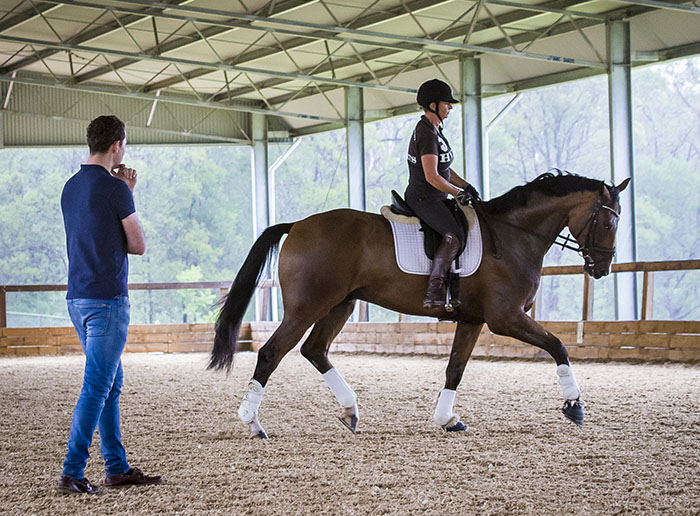
By the end of the lesson, Caroline had Ben calm, supple and smooth resulting in quite a few “ooos and ahhs” from the gallery.
Next a Stefan fan
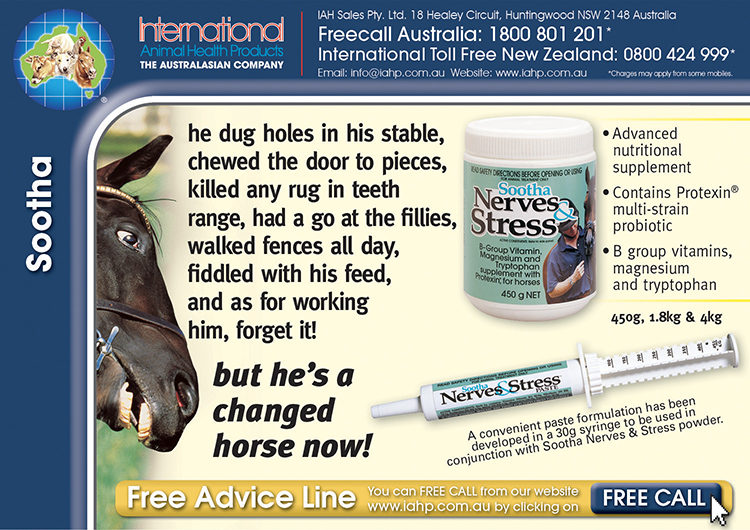 Brett Peel can’t get enough of Stefan. Fresh from a five-week stint with him in Germany, Brett brought along four horses. With his own Geordie Boy, the work focused on increasing collection the correct way.
Brett Peel can’t get enough of Stefan. Fresh from a five-week stint with him in Germany, Brett brought along four horses. With his own Geordie Boy, the work focused on increasing collection the correct way.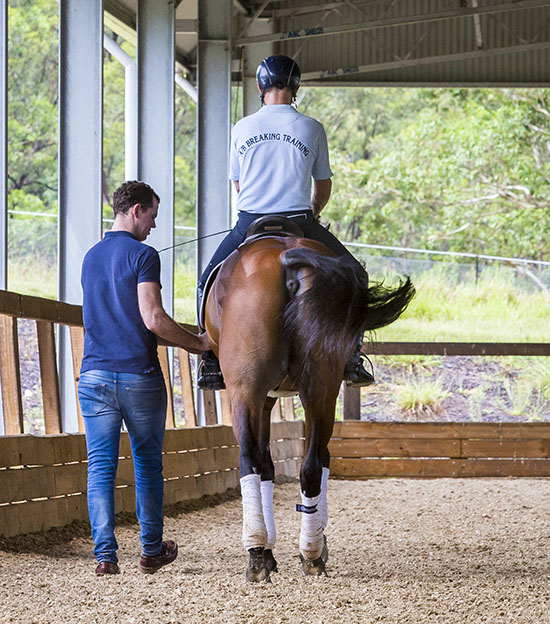 Again, it was keeping the horse in balance and allowing him to stretch forward through the neck even as he came back in collection. “If he tightens through the shoulder and withers when you collect up a bit, you need to ride him through again. He cannot contract the muscle at the wither/ base of the neck. When he collects, he still needs to reach forward. He needs to still take you forward as you bring him a little bit back.”
Again, it was keeping the horse in balance and allowing him to stretch forward through the neck even as he came back in collection. “If he tightens through the shoulder and withers when you collect up a bit, you need to ride him through again. He cannot contract the muscle at the wither/ base of the neck. When he collects, he still needs to reach forward. He needs to still take you forward as you bring him a little bit back.”
“Push his neck to the rein, but don’t push him out of collection. Even if he struggles a bit, keep the tempo. Even if he canters, don’t give up your aid. Trust the aid and let time work for you.” And there was that timing focus again; reacting at the correct strength in the correct way at the correct time, “I want 5cm more in the neck length, but don’t give too quickly. Don’t over-react. Place an aid and wait to see what happens instead of fiddling around with your hand or your leg.”
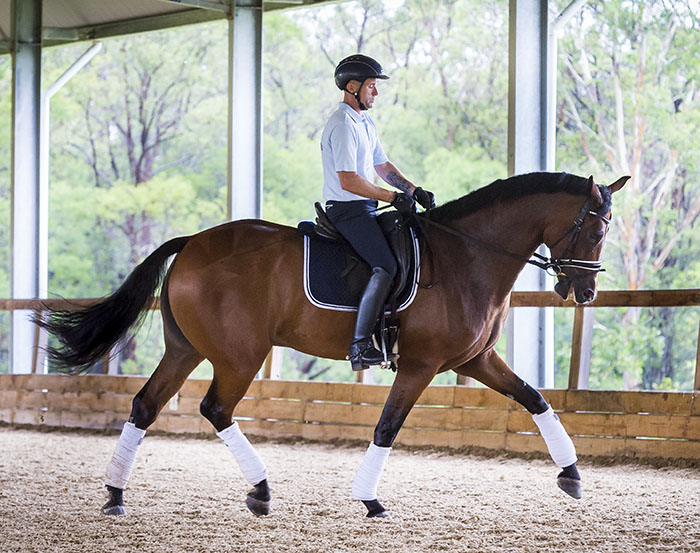
The new work meant that Geordie Boy still had a slightly incorrect reaction and Stefan explained further, “He wants to hold the stride in the air a bit longer, but don’t allow that yet. Ride him forward but hold with your seat.” Brett had to alter his position slightly to encourage the gelding to work on his own a little more. “Become slack in your shoulders. Be technically helpful, but not so much physically helpful. That forces the horse to do more. Sometimes they trot big and you try to preserve it, but try not to do that. Let him be responsible for maintaining it.”
Stefan wanted to touch on the stretchy rising trot as it’s a movement he believes isn’t often performed well in the five-year-old test. “It’s in the test for a reason, to see if the horse has been trained under tension or if it has created its own positive tension which can be maintained when the aids are lightened. Don’t drive more, just release with your thigh, bend your knee and let your calf be on him. He shouldn’t jump away from the leg. You should squeeze him and he should go with it, not leave the squeeze behind. To bring him back, hand forward and settle back with your seat.”
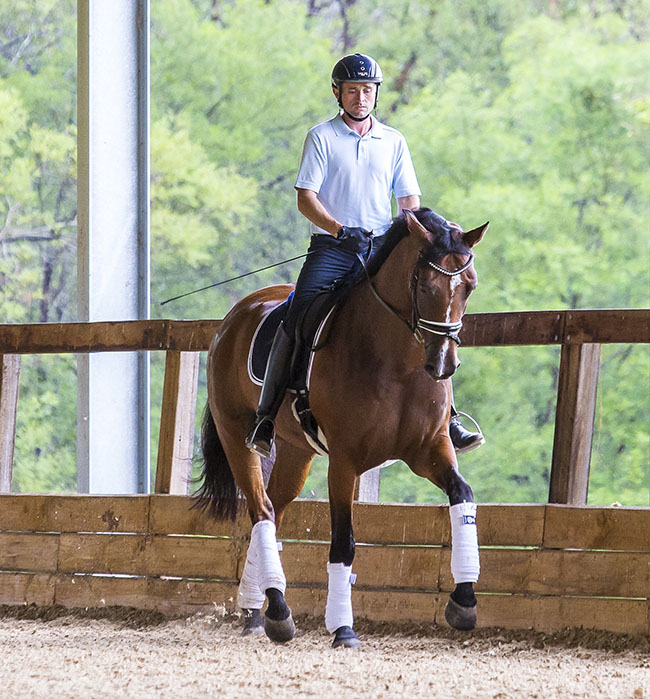
And a few words of encouragement for Brett, “ At this stage, keep the work natural and realistic. He’s not a 10-year-old. Don’t put that pressure on yourself. Don’t interfere too much. Now he works through his body better, he’s not holding his frame.”
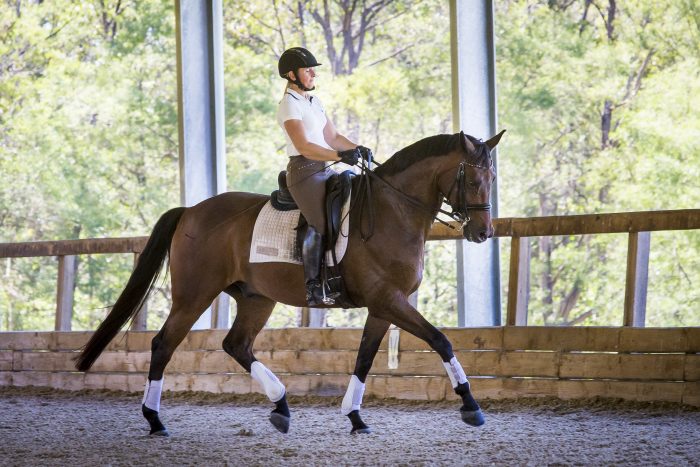
Linda Foster’s Neversfelde Samiro is ready to jump up into the FEI ranks. The focus of her lesson was pirouettes, getting the horse expressive without tension. Stefan talked Linda through the process, “Let him come to your outside leg a bit. Give him more time to load the hind leg. You seem worried for some reason that he will not be fast enough in the hind leg. When you keep hammering the hind leg, you don’t get enough time to get suppleness in the back. Proper pirouette canter is four-beat which means the horse needs more time. Get him in front of the inside rein and more to the bit. Give yourself time to relax more through your spine. Keep your calf closed, but your knee and thigh need to be soft. Don’t let him push your seat to the front leg. Sink your seat in between the forehand and hind end. He needs to receive your seat and your leg needs to receive the horse.”
“If you do that, then your aids aren’t so loaded that you feel like you can’t do anything else. You should only have about 60% of your aids engaged so you have enough options in your aids to react to what might come up or so you can ride out of the pirouette again. Let him live under your good aids.”
“Off the leg is not a technical term. We don’t want him off the aid, we want him on the aid. If they are off the leg, you have no control and they can break out of the canter. He needs to come to your leg, to seek it.”
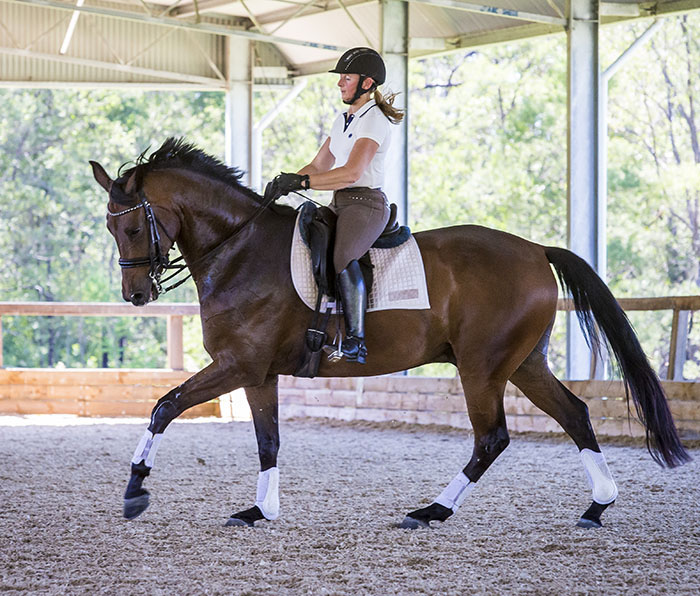
The walk to canter aid was not to be too forward and running away, just that the horse reacted to the leg. At this level, not all reactions to the aids need to be forward, just create a softness and reaction in the horse’s body. An exercise to help this was cantering from the rein back, “It’s enough if he canters on the spot from the rein back. It’s still a forward reaction. Ride straight into the pirouette canter. Don’t ride forward first, and then have to bring him back. Even when he drops into trot, don’t lose your canter aid. Same pressure with the leg as when you ask for the canter out of the rein back. Keep that aid. Then afterwards, if they are on the leg, you don’t have to push them out, just release.”
The trot at the end proved how effective the work had been for the horse, “Ja! Exactly! The collected work is good enough for 7.5. That’s 75% so don’t think that it isn’t good enough.”
now a horse that finds the arena stressy
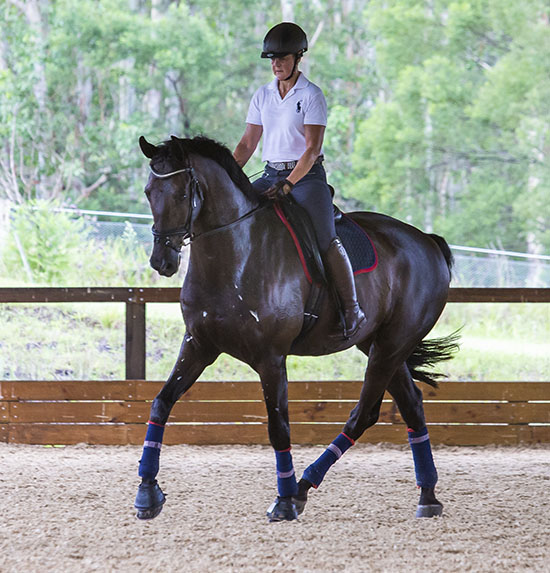 Jennifer Morris’s horse found the new surroundings a bit stressful. It’s easy to lose some focus when the tension is up, but Stefan encouraged Jennifer to remain focused on the basics to get the horse back with her. The track was a “scary zone” but Stefan tried to change Jennifer’s thinking when she was trying to stay close to the rail, “Don’t let those minor things disrupt your riding. Again, the diagonal aids. Outside rein/inside leg. The outside rein is important. Keep it and make it steady. Give him time but keep him obedient to the aid, not to the environment. If you want to push a horse toward something, it doesn’t make sense, you want to keep him on your aids. The horse needs to come to you, not to the wall, you just happen to be next to the wall.
Jennifer Morris’s horse found the new surroundings a bit stressful. It’s easy to lose some focus when the tension is up, but Stefan encouraged Jennifer to remain focused on the basics to get the horse back with her. The track was a “scary zone” but Stefan tried to change Jennifer’s thinking when she was trying to stay close to the rail, “Don’t let those minor things disrupt your riding. Again, the diagonal aids. Outside rein/inside leg. The outside rein is important. Keep it and make it steady. Give him time but keep him obedient to the aid, not to the environment. If you want to push a horse toward something, it doesn’t make sense, you want to keep him on your aids. The horse needs to come to you, not to the wall, you just happen to be next to the wall.
“Keep yourself on the track rather than the horse. Give him time, don’t chase him, but keep him on your aid. Don’t collapse your entire aid when the horse does something. Give one aid and make it consistent instead of having five different variations of it. He gets confused. Don’t give your horse the feeling that you’re indecisive. This can be a problem. Some horses can act up to this because they get contrary signals.”
Stefan is always thinking about how the horse’s brain works. He’s spent a lot of time studying horse behaviour and that’s one of the reasons why he’s so good at finding the best way for the animal. He was happy to let the horse consider spooky situations, but it had to keep moving forward. It’s another reason why he was so strict with the diagonal aid with all of the riders, “Ride enough that he won’t turn around, but give him time. That’s how horses work. They stop to look at things. You don’t have to stop, but give him time. Keep moving and be decisive with your seat and leg. Then he won’t come off the line even when you give with the inside rein.”
“The inside leg assures that he is consistently looking for the outside rein. Come on, get him sensitive. If you’re too busy with your inside rein, it takes the focus off the inside leg. Try to get rid of the thinking that everything will fall part if you give the inside rein. The inside rein is important, but that comes later. You have to be more effective with your inside leg and then later on you have more options. Condition him to your inside leg. Get him to recognise it. Work every stride with the inside leg.”
Stefan wanted the horse confident enough to step firmly up to the bridle. Putting the aids in place and leaving them there would give the horse confidence but at the same time, the horse needed to be able to move within the aids. “You press him then wait until he takes the bridle and moves on. There you go, now you have an even contact.”
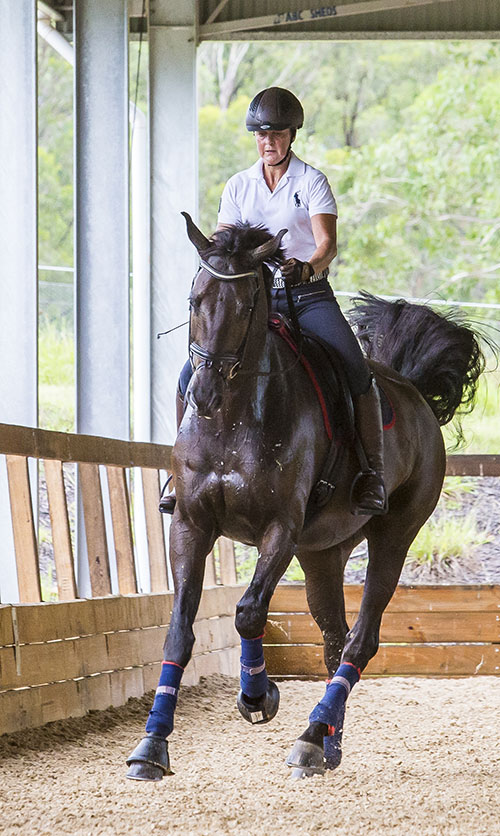
Jennifer was left with the final thought, “Be consequent, decisive, and don’t make it complicated,” and that’s a great takeaway for all of us. Make it easy for the horse and allow him to do his job without restriction.
An interview with Stefan…
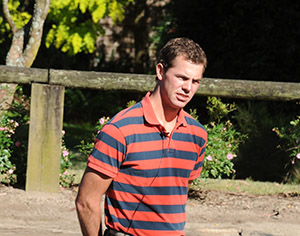
There are a few common problems you see, right through the levels from novice through to the top, things such as open mouths, tongues up and lateral walks and canters. Can you touch on these a bit?
Mouth issues, I mean it depends what it is, but if you look at tongue being up, it’s a sign of a muscle contraction, the tongue is a muscle and it’s contracted so it’s short. The tongue is basically connected to the muscles going through the poll and attaching to the under neck. So usually when the tongue is consistently up, it runs through the entire horse; through the neck and to the back of the horse. You can really see that entire chain of the body being tight.
The tongue up is really only the symptom. So you have to start suppling the entire horse starting from behind. Not ride for hours on the long rein, you also need to make sure the horse lengthens only as much as it stretches and not more than that. Then, pick it up again, put it into a bend and ride walk/trot, trot/canter transitions; consistent variations so the horse starts suppling through. But you have to start from the back, the back starts to supple from the bend and the variations of the neck carriage, and the neck will start to supple also, right though to the tongue. Also, if the back gets softer, it lets the hind leg come under more. So you start seeing the back move and you start seeing a better over track, which can be a problem even in the working trot. A lot of horses don’t do that. You see the neck starting to drop and usually it’s the last thing, the tongue goes down and the mouth closes. But it is a process.
Lateral walk and canter can be a problem, because it’s usually developed over a long time. Let’s start with the lateral canter, it pretty much means that the diagonal support phase is interrupted and you have the outside front leg landing too early or the inside hind leg landing too late which really means that horse avoids taking weight in the inside hind leg. and the support comes first on the outside front leg.
You usually have several problems – a lack of self carriage, a lack of activity and a lack of straightness. In my experience, those three things come together. Also, a lot of times you have the lateral canter only on one rein and interestingly enough, a lot of times toward the stiff side. If you would turn back the wheel to think about what you did as a rider, you probably wanted to collect and collect while the horse was always strong on that inside rein. Sometimes you just pick the horse up instead of half halting properly. What happens? The horse gets evasive and braces on the stiff side against the inside hand and that can immediately tighten the back and cause a lateral canter over time, so the stride gets shorter not collected.
At the end of it, you need to straighten your horse, especially to the stiff side, make sure your inside hand, as much as you can, is giving so that the inside leg pair can reach through again.
But don’t think to string out and ride forward, light seat and let go – that usually brings the horse more on the forehand because it is already off balance. Think self carriage, poll in front of you and quick behind.
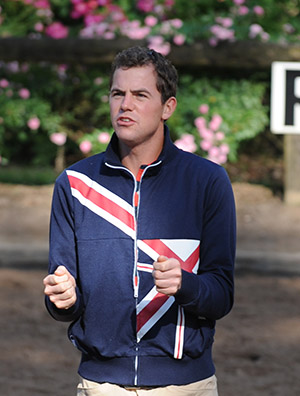
Biggest mistakes or time wasters you notice people doing…
That’s a bit too general. It’s so various. But what you really see a lot is that the diagonal aid is not performed properly. Bending the horse, I feel sometimes is not fully understood or rider may not pay enough attention to it. The fact is that if you bend a horse, it should relieve the entire inside body half and not actually put pressure on it. Horses should have freedom in that inside shoulder to move through the corner and not be restricted.
For those training a lot on their own, do you have any suggestions?
Train on Youtube?!! I think that is always a high risk. You need to understand that it is huge risk when you train a lot by yourself. It can be a problem. The biggest problem is that we start reflecting on the horse only and not on ourselves, and the effect we have on the horses, which should really be the idea of riding. Every other athlete focuses on himself because there’s no other chance, but we always have the option and risk of just focusing on our partner. When you are a dancer, it might be a little bit the same but even then, they focus on themselves and watch each other.
These days everyone has access to educational films and you can watch shows that are thousands of miles away and yes, these things do help. At the same time, it’s always one thing to see it, and theoretically understand it, and another to put it together. I do think that the person on the ground can never be exchanged for that. I think it’s so beneficial to have that good, basic training. Find someone that you like and you trust and even if it’s not a formal training, someone on the ground can help, someone who can watch and regularly be your eyes.
find more Stefan – see below
Thinking of breeding a dressage horse? How about Quatensprung – already a top performer and producer – from the Donnerhall line – complete with colour! Enquire now for a special rate while stocks last Ring Glenis on 03 5439 7251 International Horse Breeders
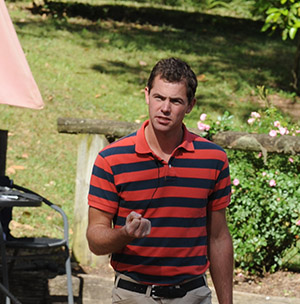
Read the companion article http://www.horsemagazine.com/thm/2017/03/stefan-wolff-gives-a-lecture-throughness/
Or go to our Dressage Library to find the world’s best collection of dressage training articles…

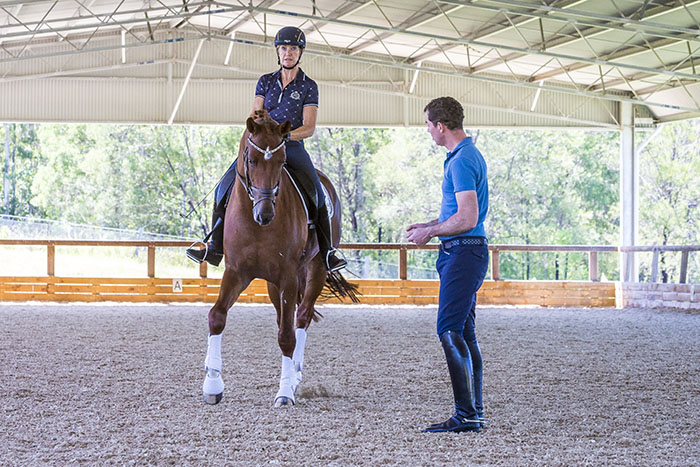
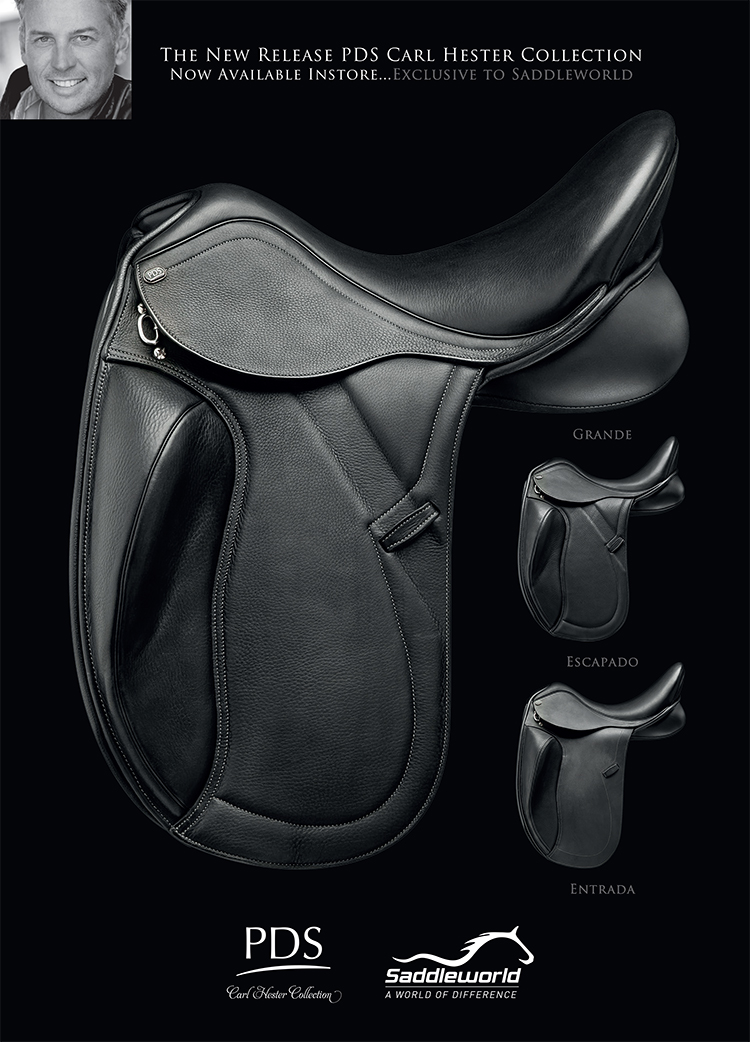
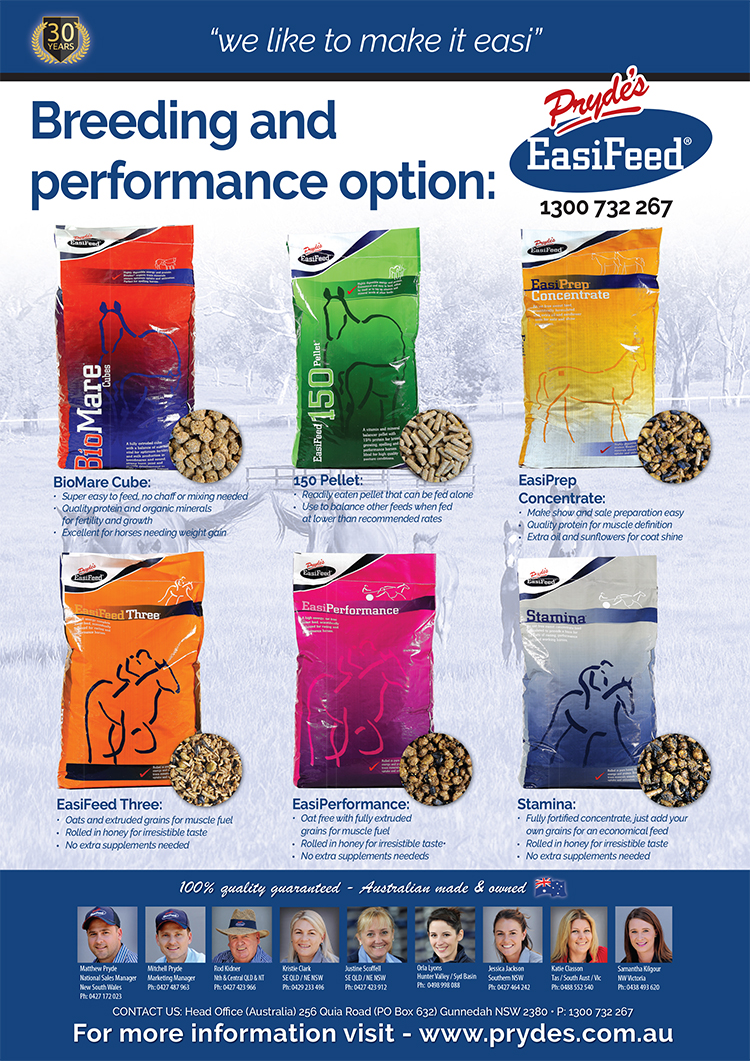
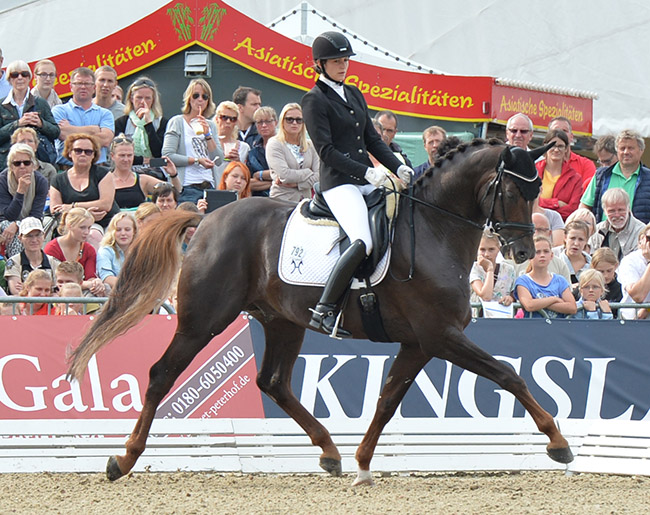
I had a friend that was looking into dressage training. It is helpful to read that there is a need for the training not by yourself so that you ensure that attention is paid to the horse. This will help her a lot as she goes forward with her research.